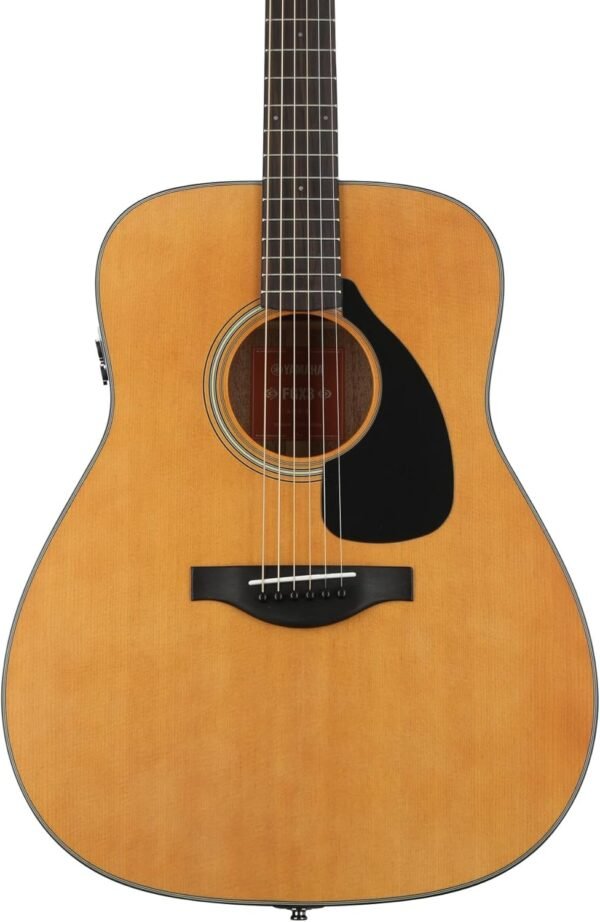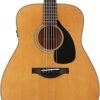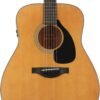Yamaha Red Label FGX3 Acoustic Guitar review exploring sound, craftsmanship, and performance
Yamaha Red Label FGX3 Acoustic Guitar review exploring sound, craftsmanship, and performance
- Rich and resonant tone that fills the room beautifully, making it ideal for both strumming and fingerpicking styles.
- The smooth neck finish feels incredible during long playing sessions, ensuring comfort and ease of movement.
- Impressive acoustic projection that allows for a balanced and lively sound even without amplification.
- Plugged-in performance is exceptional, thanks to the Atmosfeel electronics, which deliver a natural and clear amplified tone.
- Classic and timeless design, enhanced by the semi-gloss finish and iconic headstock shape, adds to its overall aesthetic appeal.
As an Amazon Associate I earn from qualifying purchases.
Description
Nostalgic Design with Modern Performance
I had the pleasure of testing the Yamaha Red Label FGX3 – Natural, and the design alone took me back to a different era. This acoustic-electric guitar is clearly inspired by the 1960s Nippon Gakki Red Label guitars, and it’s not just a marketing gimmick. The semi-gloss finish and the classic V-shaped headstock are charming details that scream vintage, but the modern tweaks make it a great choice for today’s musicians. The solid spruce top paired with mahogany back and sides gives it an aesthetic that feels both timeless and fresh.
The dimensions (47 x 23.07 x 8 inches) make it manageable for players of varying sizes, and at 18 pounds, it’s not overly heavy for an acoustic-electric. The natural finish caught my eye immediately—it’s understated yet elegant, perfect for someone who doesn’t want anything too flashy while still appreciating craftsmanship.
Sound Quality: A Blend of Tradition and Innovation
The sound of this guitar really stands out, and I couldn’t help but notice the impact of the A.R.E. wood torrefication process. This technology enhances the tonewoods, giving the guitar a warmer, fuller sound that feels “played-in” right out of the box. I found the balance across all strings to be exceptional, which is likely due to the updated scalloped bracing.
Plugging it in was just as satisfying. The Atmosfeel electronics system delivers a natural, amplified tone that doesn’t feel artificial or overly processed. Whether I played fingerstyle or strummed aggressively, this guitar offered consistent performance. It’s one of those guitars that invites you to keep playing just to hear what else it can do.
Key Benefits
- Rich, warm tone thanks to the A.R.E. wood torrefication process.
- The Atmosfeel electronics system ensures excellent sound when plugged in.
- Updated scalloped bracing enhances resonance and volume.
- Solid mahogany back and sides provide a strong, balanced sound.
Limitations
Despite its many strengths, there are areas where this guitar could improve.
- The 18-pound weight might be a bit much for some players, especially during long sessions.
- The fixed bridge system, while reliable, limits flexibility for some advanced techniques or modifications.
- Bronze strings may not suit every player’s preferences, as they can feel a bit stiff initially.
Playability and Comfort
I found the African mahogany neck to be incredibly smooth and comfortable for my hands. The ebony fretboard adds to the luxurious feel, and the frets are well-finished, with no sharp edges—a small but important detail. It’s a six-string guitar, and the string spacing feels perfect for both beginners and seasoned players.
Playing it acoustically, I was impressed by the projection and clarity. The bronze strings paired with the spruce and mahogany body produced a bright yet warm sound. The guitar also stayed in tune remarkably well, even after some vigorous playing.
Areas for Improvement
- Weight could be reduced for better portability.
- The fixed bridge system may not appeal to players who frequently adjust their setups.
- While the semi-gloss finish is beautiful, it does tend to show fingerprints quite easily.
Product Competitors
When comparing this guitar to other models, a few options stood out. The Taylor 214ce is a similar acoustic-electric guitar that offers a brighter tone but lacks the warmth provided by Yamaha’s A.R.E. wood technology. Another contender is the Martin D-10E, known for its rich bass response but lacking some of the electronic sophistication found in the Atmosfeel system.
Where the Yamaha excels is in its ability to blend vintage aesthetics with modern functionality. It offers a more balanced sound compared to the Taylor and a more refined build quality in comparison to the Martin at a similar price point.
Quality for Price
After testing it extensively, I’d say this guitar offers excellent quality for its price. The combination of solid tonewoods, innovative electronics, and vintage-inspired design feels like a steal compared to other guitars in the same category. While it may not be the cheapest option out there, the features and craftsmanship make it worth considering. Whether you’re an amateur or a professional, this guitar delivers a satisfying experience for its cost.
Final Thoughts on the Yamaha Red Label FGX3
The Yamaha Red Label FGX3 – Natural is a guitar that bridges the gap between classic charm and modern innovation. Its solid mahogany construction, A.R.E. wood process, and Atmosfeel electronics make it a standout choice for musicians who value both tone and aesthetics. While it isn’t perfect, its strengths far outweigh the minor drawbacks, making it a worthy addition to any guitarist’s collection. Whether you’re jamming at home or performing on stage, this guitar is built to impress.
Additional information
| Item Weight | 18 pounds |
|---|---|
| Product Dimensions | 47 x 23.07 x 8 inches |
| Item model number | FGX3 |
| Is Discontinued By Manufacturer | No |
| Back Material | Mahogany Wood |
| Body Material | Mahogany |
| Color Name | Natural |
| Fretboard Material | Ebony Wood |
| Guitar Pickup Configuration | P-? |
| String Material | Bronze |
| Top Material | Spruce Wood |
| Neck Material Type | Mahogany |
| Number of Strings | 6 |
| Guitar Bridge System | Fixed |



